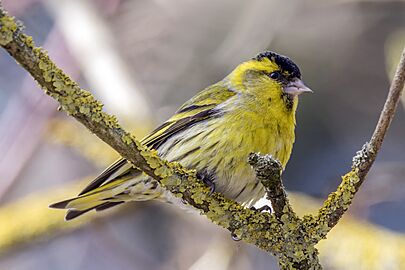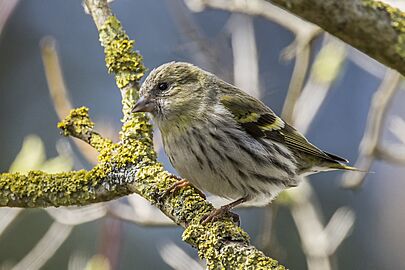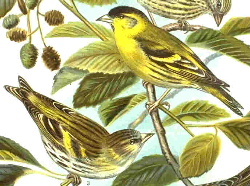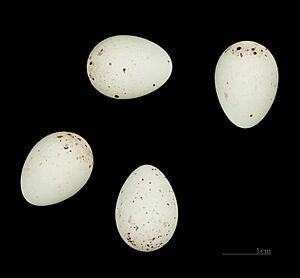Eurasian siskin facts for kids
The Eurasian siskin (Spinus spinus) is a small songbird from the finch family. It's also known as the European siskin or just siskin. You can find these birds all over Europe and Asia, especially in forests with cone-bearing trees (like pines and spruces) and mixed forests. They love to eat seeds, especially from alder trees and cone-bearing trees.
You can tell the siskin apart from other finches by its colors. Its back is greyish-green, and its belly is white with grey streaks. Its wings are black with a bright yellow stripe, and its tail is black with yellow sides. Male siskins have a mostly yellow face and chest, with a neat black cap on their head. Females and young birds have a greyish-green head and no black cap. Siskins are friendly, social, and active birds. Their song is a lovely mix of chirps and trills. Because of this, they are sometimes kept as pets.
These birds have an unusual way of migrating. Every few years, many of them fly south for winter. Scientists aren't sure why, but it might be because of the weather or how much food is available. This helps them find plenty of food during winter. The siskin is also a very acrobatic eater, often hanging upside-down like a titmouse to get seeds. They will even visit bird feeders in gardens.
Quick facts for kids Eurasian siskin |
|
|---|---|
 |
|
| Male | |
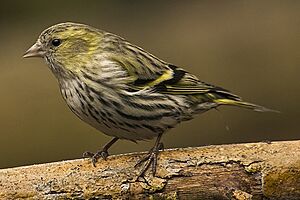 |
|
| Female |
|
| Conservation status | |
| Scientific classification | |
| Genus: |
Spinus
|
| Species: |
spinus
|
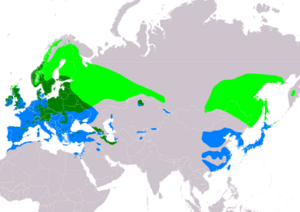 |
|
| Range of the Eurasian siskin Breeding Resident Non-breeding |
|
| Synonyms | |
|
|
Contents
About the Eurasian Siskin
Naming and Scientific Classification
The siskin was first described by a famous scientist named Carl Linnaeus in 1758. He gave it the scientific name Fringilla spinus. Later, it was placed in the genus Carduelis, and now, after more studies, it's in the genus Spinus. The name Spinus comes from an ancient Greek word for a bird. The English name "siskin" comes from a German word.
Even though siskins live in many different places, they are all considered the same species. There are no different types or subspecies. This might be because they move around a lot, which helps them mix their genes. Also, females can lay eggs in different places during one breeding season.
What Siskins Look Like
The siskin is a small bird with a short tail. It is about 11 to 12.5 centimeters (4.3 to 4.9 inches) long. Its wingspan is about 20 to 23 centimeters (7.9 to 9.1 inches), and it weighs between 12 and 18 grams (0.4 to 0.6 ounces).
Male and female siskins look a bit different.
- Males have a greyish-green back and a yellow rump (the area above the tail). The sides of their tail are yellow, and the tip is black. Their wings are black with a clear yellow stripe. Their chest is yellowish, becoming whiter and striped towards the belly. They have a black patch under their chin and a black cap on their head. The size of the black chin patch can show how dominant a male is in a group.
- Females are more olive-colored than males. Their head and ear areas are greenish, and they have a white chin patch. Their rump is a slightly striped yellowish-white.
- Young birds look similar to females but have duller colors.
The siskin's beak is strong but slender, perfect for picking up seeds. Their legs and feet are dark brown, and their eyes are black. Siskins fly quickly and in a bouncy way, similar to other finches.
It's usually easy to spot a siskin. However, sometimes they can be confused with other finches like the citril finch or the European greenfinch. Adult male siskins are bright green and yellow with a black cap. Adult females also have green and yellow colors, especially on their face and chest. The underside of a siskin is usually pure white. In females and young birds, the middle of the belly is often plain white without streaks. Their wing stripes are wide and yellow, and their beak is short and curved.
Where Siskins Live
You can find siskins across most of Europe and Asia, and in northern Africa. They breed in two main areas: the eastern coast of Asia and the central and northern parts of Europe.
Some siskins live all year round in Central Europe and in some southern European mountains. They are found in northern Scandinavia and Russia. In winter, they fly to warmer places like the Mediterranean region and around the Black Sea. In China, they breed in the Khingan Mountains and Jiangsu province, and spend winter in Tibet and other southern areas.
Siskins are sometimes seen in North America, where they have a similar relative called the pine siskin.
Their migration is unusual. Every few years, many more siskins fly south for winter. One idea is that this happens when Norway spruce trees produce lots of seeds in central and northern Europe, which causes siskin numbers to grow. Another idea is that they migrate more when their favorite food, alder or birch seeds, is scarce. Outside of breeding season, siskins often form large flocks, sometimes mixing with other birds like redpolls.
Siskins don't stay in one place for long. They change their breeding and feeding areas from year to year.
They prefer forested areas, especially humid ones. They particularly like forests with cone-bearing trees, like spruce, for breeding. They build their nests in trees and lay 2 to 6 eggs. In Britain, the number of siskins has grown a lot because more conifer tree farms have been planted. Siskins also breed in mixed forests. In winter, they prefer fields with leftover crops and areas with seed-bearing trees.
Eurasian Siskin Behavior and Life Cycle
Daily Life and Social Habits
Siskins are very active and restless birds. They are also very social, forming small groups, especially in autumn and winter. They are quite trusting of humans, so you can often watch them from a short distance. However, during the breeding season, they become shyer, more solitary, and harder to see. There's even a German legend that says siskins guard a magic stone in their nests that makes them invisible! Siskins are one of the few bird species known for "allofeeding," where birds of the same sex share food with dominant members of the group. This helps keep the flocks together and shows there's a pecking order within the group.
What Siskins Eat
Siskins mainly eat seeds, but their diet changes with the seasons. They usually feed in trees and avoid eating on the ground.
- Autumn and Winter: They mostly eat seeds from trees like birch and, most importantly, alder. They also visit farms and pastures, where they join other finches to eat seeds from plants like thistles, dandelions, and other wild plants.
- Spring: During the breeding season, they are found in forests with cone-bearing trees. At this time, they eat seeds from these trees, especially spruce, fir, and larch. They also eat seeds from elm and poplar trees. When feeding their young, they eat more insects, mainly beetles. The protein from insects helps the chicks grow strong.
- Summer: Their diet is more varied. They still eat conifer seeds but also add seeds from other plants like goosefoot.
Reproduction and Family Life
Male and female siskins usually form pairs in winter before they migrate. Males will compete fiercely for females. To attract a female, the male puffs up his feathers, making himself look bigger. He also spreads his tail and sings a lot. They also fly from tree to tree in a special way, though it's not as flashy as other finches.
Siskins build a small, cup-shaped nest. It's usually placed high up on a branch of a cone-bearing tree, making it hard to see. They often form small groups of up to six pairs, with nests close to each other. The nest is made from small twigs, dried grasses, moss, and lichen, and it's lined with soft feathers.
The first set of chicks is usually born in mid-April. The female lays between 2 and 6 eggs. The eggs are white, light grey, or light blue, with small brown spots. They are about 16.5 mm by 12 mm in size. The female sits on the eggs for 10 to 14 days until they hatch. The chicks are born helpless and without feathers. They leave the nest after about 15 days, still partly feathered. They stay near the nest for about a month until their feathers are fully grown, then they fly off on their own. Siskins usually have a second set of chicks from mid-June to mid-July.
Songs and Calls
Siskins have two main calls, one that goes down in pitch and one that goes up. You can imagine them sounding like "tilu" and "tluih." Sometimes, they also make a harsh, rattling chirrup.
Their song is similar to other finches: a smooth, fast twittering and trilling sound that lasts a long time. It's sometimes broken up by a stronger or shorter sound. Siskins sing all year round, and they often sing in groups.
Eurasian Siskin Status and Conservation
There are many siskins in the world, estimated to be between 20 and 36 million birds. In Europe, there are about 2.7 to 15 million pairs. Their numbers don't seem to be decreasing much. Because of this, the IUCN (International Union for Conservation of Nature) lists them as a species of "least concern," meaning they are not currently at risk. The siskin is also listed as a protected bird species in the Berne Convention, an international agreement for wildlife conservation.
Siskins and Humans
Like many finches, siskins are popular pets because of their song and pretty looks. They don't need special care and adapt well to living with humans, though they don't breed easily in captivity. They don't have many specific diseases, but they can get stomach problems if their diet isn't good. In captivity, they can live for 11 to 14 years, which is much longer than the 2 or 3 years they might live in the wild.
Siskins can sometimes breed with other finches, like canaries, creating mixed birds. This can also happen in nature without human help. In some areas, siskins found in the wild might be birds that escaped or were released from captivity.
Siskins in Culture
Siskins have appeared on postage stamps in countries like Poland, Gibraltar, Benin, and Belgium.
In Saint Petersburg, Russia, there is a statue of a siskin. This is because the bird's colors are the same as the uniform worn by students at a special school in the city. These students became known as "siskins." This nickname became famous in a Russian song called "Chizhik-Pyzhik." A statue of a siskin has been on an embankment by a bridge since 1994, though it has been stolen and replaced many times.
There's also a Czech folk song and dance called "Čížečku, čížečku" where the siskin shares secrets about poppy plants.
In the novel Three Daughters of Eve by Elif Shafak, a siskin appears in an important scene. The main character, Peri, finds a yellow-green siskin with a forked tail trapped among books in a professor's office.



